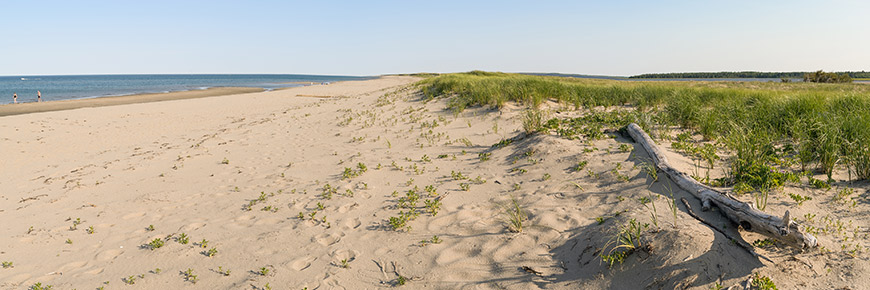
Piping plover recovery
Kouchibouguac National Park
Piping Plover (Charadrius melodus melodus)
In Mi’gmaq: Jijuikate’j
SARA Status: Endangered
The Piping Plover is a small shorebird that is found only in North America. It has a pale, sand-coloured back, short stout bill and orange legs. During the breeding season, it also has a single black band across the breast, another black band across the forehead between the eyes, and a distinctive black tip on the orange bill.
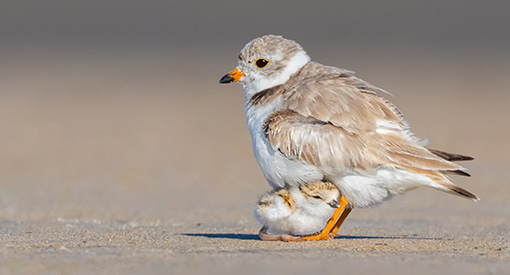
Over one third of the global breeding population of Piping Plovers are found in Canada, and over one half of the breeding range. The Piping Plover has been designated as endangered or at risk of extinction by the Committee on the Status of Wildlife in Canada (COSEWIC) since 1985, and has been the focus of extensive research, conservation and recovery efforts over the last 50 years.
Habitat
Across its breeding range, the Piping Plover nests on wide sandy beaches with little vegetation and a mix of substrates such as pebbles, gravel, shells and sticks. In the Canadian Great Lakes and at Lake of the Woods, Ontario, Piping Plovers nest on sand and pebble beaches of freshwater dune formations on barrier islands, peninsulas or shorelines of large lakes. On the Atlantic coast, they are associated with sandy beaches on barrier islands, oceanfronts, bays and sand bars.
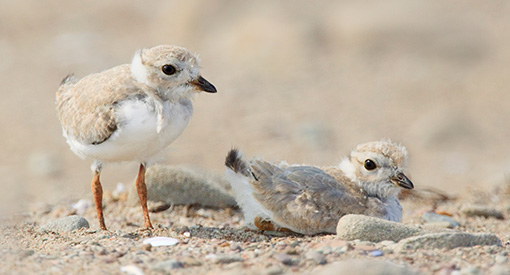
In the spring, this small shorebird nests along the park’s golden sand dunes following a long flight from the Caribbean, often returning to the same nesting area in consecutive years. After finding the perfect place to nest along the dunes of Kouchibouguac National Park, the Piping Plover makes a modest nest by digging a simple depression in the sand and camouflages its clutch among gravel, pebbles, driftwood, and pieces of shells. Four eggs are laid, and hatch after about 28 days. Both parents incubate the eggs and tend the chicks. Chicks are able to fly 18 to 35 days after hatching. As soon as they hatch, the chicks must be able to access the edge of the water in order to feed on invertebrates and store enough energy to complete their first trip to the Caribbean in the fall.
Threats
The key threats to Piping Plovers are predation (primarily of eggs and chicks), human disturbance, and habitat loss or degradation. Some natural predators have increased with increasing human presence, and domestic and feral animals also prey on Piping Plovers. Human disturbance has direct effects on Piping Plovers through the destruction of eggs or nests, and several indirect effects such as distracting birds from nesting and feeding activities, and leaving tire tracks on breeding beaches that make feeding more difficult for the plovers and can trap chicks. Human activities, including development, recreation, and resource extraction, reduce the amount and quality of habitat available to the Piping Plover on breeding grounds and wintering grounds. Climate change poses a growing threat, particularly on coastal breeding and wintering grounds, where an increase in severe storms and rising sea levels are expected to reduce the amount of available habitat.
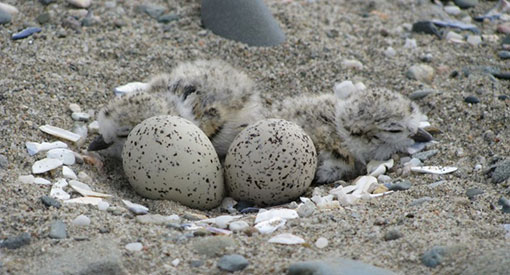
Since the piping plover depends primarily on its camouflage as a defence mechanism and its nests and clutches are vulnerable, the park's management prohibits access to certain sections of the beaches in the hopes of reducing disturbances and increasing the species reproductive success rate. In addition, pets are prohibited at all times along the park's barrier islands to reduce disturbance to Piping Plovers and other migrating shorebirds.
An annual census is conducted from early May to mid-August along the entire 25 km of coastline. Nest locations are marked, then are monitored every 3 to 5 days for bird observations, breeding pairs, and/or nest activity. Additional information on the outcome and progress of each nest is recorded in order to relate productivity with the fate of the clutch. This monitoring is carried out for the duration of the breeding season, until all chicks have fledged and all adults have left the Park beaches. Remote cameras are also used on occasion to help us learn why nests fail and what type of predators are present.
Parks Canada and its partners - Environment and Climate Change Canada and Nature NB - and volunteers are working together to protect this small, endangered shorebird. Parks Canada is a leader in the recovery of species at risk and we are acting to ensure the recovery of Piping Plovers to improve the health of our National Parks. So far, the results are encouraging, and the rapid decline in numbers seems to have slowed. But the Piping Plover still needs our help in order to survive long into the future.
Want to help?
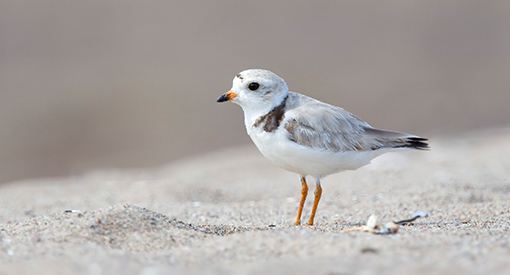
There are many things you can do to help support Piping Plover recovery efforts:
- Keep beaches clean. By picking up trash at the beach, even biodegradable items (apple cores and fruit peels), you help reduce the risk of artificially attracting the shorebirds’ natural predators such as seagulls and crows who love snacking on the Piping Plover’s vulnerable eggs.
- Respect closed areas.
- Please keep dogs off dunes at all times.
- Date modified :